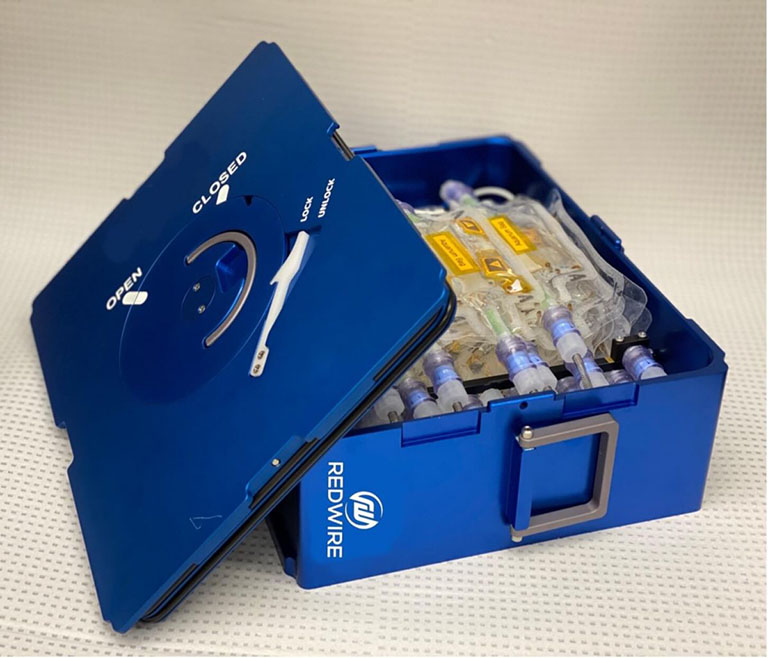KENNEDY SPACE CENTER (FL), November 16, 2023 – Approximately 90 percent of all small molecule medications for common ailments, like aspirin and antihistamines, are formed as crystals. The structure and purity of these crystals are crucial and can have an impact on how the drug is administered to a patient. To optimize and improve treatment options for patients affected by diseases such as diabetes, cardiovascular disease, and even chronic pain, pharmaceutical companies are turning to the International Space Station (ISS) National Laboratory to leverage its unique environment to grow new crystal forms and more homogenous crystals.
Previous space-based research has shown that in the absence of gravity, crystals often grow more uniformly and contain fewer imperfections than their terrestrial counterparts. To that end, Redwire Corporation (NYSE: RDW) developed an in-space pharmaceutical manufacturing platform called the Pharmaceutical In-space Laboratory (PIL) Bio-crystal Optimization eXperiment (BOX) to crystallize small organic molecules in microgravity. Essentially a “lab-in-a-box,” the facility will enable pharmaceutical companies and researchers to grow small-batch crystals for protein-based pharmaceuticals.
The PIL-BOX, which was recently installed on the orbiting laboratory following its launch on SpaceX’s 29th Commercial Resupply Services (CRS) mission, was designed to be a highly configurable system capable of supporting a variety of experiments and products. For its initial mission, Redwire is putting PIL-BOX through its paces and partnering with Eli Lilly and Company (Lilly) to conduct a series of experiments focused on optimizing and improving the drug discovery and development process.
“PIL-BOX is designed to take solutions of different materials from different bags and mix them together to form crystals,” said Ken Savin, Redwire chief scientist. “We’re hoping we can use this platform as a screening mechanism to grow crystals.”
The company’s Advanced Space Experiment Processor (ADSEP) houses the PIL-BOX Fluidics Cassette (FC)—a series of bags, pumps, and valves that control fluid handling operations to support the crystallization process. According to Savin, PIL-BOX can support 10 experiments at a time, and the company plans to cycle through different conditions and different samples to see if they can grow crystals in the bags.
“When you’re producing medications for people, you need to know that every dose is same,” said Savin. “So, having the ability to produce uniform crystals in space in very beneficial not only to the pharmaceutical industry, but to multiple other industries here on Earth.”
This ISS National Lab-sponsored experiment was awarded through a NASA in-space production applications solicitation aiming to stimulate demand for manufacturing in low Earth orbit. Savin is hopeful that PIL-BOX could be used to produce small amounts of high-quality crystals in space that could then be used to enhance pharmaceutical production on Earth.
“With PIL-BOX, we can take a very small amount, maybe a thimbleful of crystals, bring them back to the ground and use them as seeds to make even more crystals,” he said. “So, this enables us to tap into the power of the microgravity environment without having to send up tons and tons of material, making this an economically viable approach.”
The SpaceX CRS-29 mission launched from Kennedy Space Center on November 9 at 8:28 p.m. EST and included more than 15 ISS National Lab-sponsored payloads. To learn more about all the ISS National Lab-sponsored research on this mission, please visit our launch page.
Download a high-resolution for this release: NASA astronaut Christina Koch
Media Contact:
Patrick O’Neill
904-806-0035
[email protected]
# # #
About the International Space Station (ISS) U.S. National Laboratory: The International Space Station (ISS) is a one-of-a-kind laboratory that enables research and technology development not possible on Earth. As a public service enterprise, the ISS National Lab allows researchers to leverage this multiuser facility to improve life on Earth, mature space-based business models, advance science literacy in the future workforce, and expand a sustainable and scalable market in low Earth orbit. Through this orbiting national laboratory, research resources on the ISS are available to support non-NASA science, technology and education initiatives from U.S. government agencies, academic institutions, and the private sector. The Center for the Advancement of Science in Space™ (CASIS™) manages the ISS National Laboratory®, under Cooperative Agreement with NASA, facilitating access to its permanent microgravity research environment, a powerful vantage point in low Earth orbit, and the extreme and varied conditions of space. To learn more about the ISS National Lab, visit www.ISSNationalLab.org.
# # #








